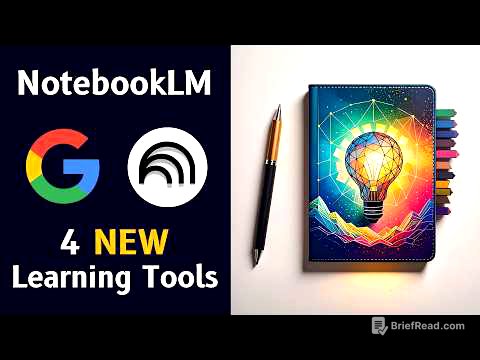TLDR;
This YouTube video transcript is a comprehensive guide to prompt engineering, covering its importance, techniques, and practical applications. It begins by defining prompt engineering and explaining why it's a valuable skill, then explores various prompting techniques like zero-shot, few-shot, chain of thought, self-consistency, role play, and RAG (Retrieval-Augmented Generation). The video also discusses the significance of LLM settings, out-of-date learning, and provides guidance on next steps for both technical and non-technical audiences interested in pursuing prompt engineering further.
- Prompt engineering is a new domain that trains people to give good input to AI, which is crucial for obtaining desired outputs and managing costs.
- Key techniques include zero-shot, few-shot, chain of thought, self-consistency, role play, and RAG, each with its own advantages and use cases.
- The video emphasizes the importance of continuous learning and practical application of these techniques to stay relevant in the evolving field of AI.
Why is prompt engineering important [0:00]
Prompt engineering is a new domain focused on training individuals to provide effective instructions, questions, and inputs to AI models. This training is essential because the quality of the output from AI models heavily depends on the input it receives. Good input leads to better outputs, making prompt engineering a crucial skill. Moreover, prompt engineering helps in optimizing the use of AI tools by reducing the number of tokens used, thereby decreasing overall expenditure for companies using AI. This domain is continuously evolving, offering numerous learning opportunities and career prospects, even for those without extensive experience.
LLM Settings [9:28]
Large Language Models (LLMs) can be used via UI or APIs. APIs allow integration of LLMs into applications, bypassing the standard UI. LLM companies release playgrounds for API testing. Key settings include: model selection, temperature (creativity), top P (probability), maximum length (restricting response length), stop sequence, frequency penalty (reduces word repetition), presence penalty, and output format (JSON). The "system user" setting allows characterization of the model, while prompt elements should include instruction, context, input data, and an output indicator.
Few shot prompting [21:01]
Few-shot prompting involves providing the model with a few examples of prompts and their corresponding responses before asking it to generate a response for a new prompt. This technique helps the model understand the desired pattern or format of the output. The advantage of few-shot prompting is that it can lead to more deterministic and predictable responses, making it suitable for applications where consistent output is required. However, it may not work well for logical or reasoning-based questions.
Chain of Thought prompting [30:05]
Chain of Thought (CoT) prompting is a technique used to improve the performance of language models on complex reasoning tasks. It involves providing the model with step-by-step explanations of how to solve a problem, rather than just giving it the answer. This helps the model to understand the reasoning process and apply it to new problems. CoT prompting is particularly useful for questions that require logical reasoning or mathematical calculations. The effectiveness of CoT prompting depends on the size of the model, with larger models generally performing better.
Self consistency prompting [39:11]
Self-consistency is a technique used to improve the accuracy of language models by generating multiple diverse reasoning paths and selecting the most consistent answer. Unlike Chain of Thought (CoT), which relies on a single, fixed answer, self-consistency involves sampling various reasoning paths and choosing the answer that appears most frequently across these paths. This approach is based on the idea that the majority perspective is often correct. The sampling process involves using temperature sampling and top-k sampling to generate diverse reasoning paths.
Out of date learning [46:20]
Out-of-date learning addresses the issue of LLMs not being continuously trained with the latest data. Since LLMs have a cut-off date beyond which their knowledge is limited, this technique involves providing the model with recent data to work on. By inputting new information, users can ask questions based on that data, enabling the model to answer even if it was previously unaware of the topic. This is particularly useful when working with recent events or specific information not included in the model's training data.
Role play prompting [52:07]
Role-playing is a prompting technique that involves assigning a specific role to the LLM to guide its responses. This technique is based on the idea that LLMs are super intelligent but need context to provide relevant answers. The process involves three steps: role assignment, actual question, and output instruction. By specifying the role, such as an experienced software engineer or a rocket scientist, and providing clear output instructions, users can tailor the model's responses to their specific needs.
RAG Theory [58:19]
Retrieval-Augmented Generation (RAG) is a prompting technique that enhances the responses of LLMs by incorporating external data sources. RAG involves retrieving relevant information from an external data source, augmenting the prompt with this information, and then generating a response using the LLM. This technique is particularly useful when the context needed for the response is not available within the LLM's training data. RAG is commonly used in company chatbots to provide customized and accurate responses based on company-specific policies and data.
RAG Example [1:06:16]
Implementing RAG involves several steps, including indexing the data source, querying for relevant information, ranking the results, and augmenting the prompt with the retrieved data. This can be done using long chains or without long chains, with long chains being the most recommended method. The process involves retrieving information, augmenting the prompt with the retrieved information, and then using the augmented prompt to generate a response using the LLM.
Next Steps [1:14:07]
For non-technical individuals, the next steps involve applying the learned techniques in daily tasks and exploring new shortcuts. For technical individuals, the next steps include learning about auto prompting, front-end frameworks like React, long chains, and transformer models in Hugging Face. Additionally, it is recommended to read research papers in prompt engineering and apply for prompt engineering intern positions to gain practical experience.






![[Densetsu.EXE Lore Video] We're Gonna Take Akiba!](https://wm-img.halpindev.com/p-briefread_c-10_b-10/urlb/aHR0cDovL2ltZy55b3V0dWJlLmNvbS92aS9rT0xwYm0wZXR2SS9ocWRlZmF1bHQuanBn.jpg)


